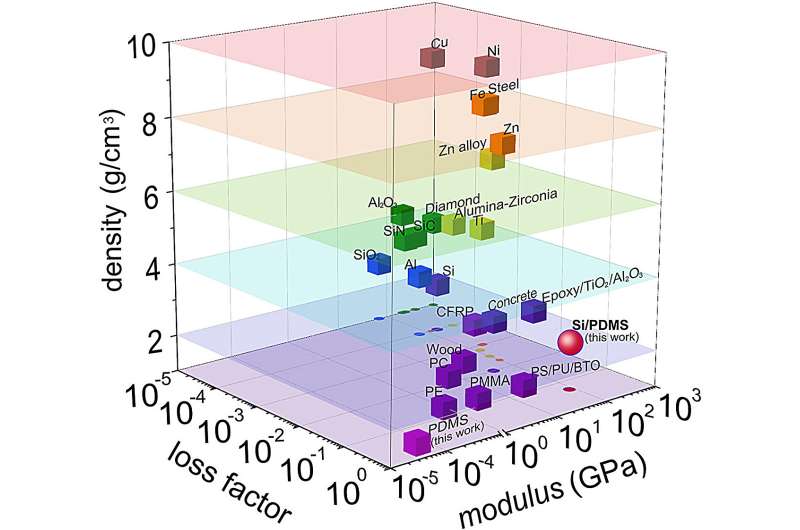A compressor hums, an air conditioning system rattles, a railway carriage chassis clatters, sending reverberations through its passengers. Vibrations are not only annoying but can also be harmful. Over the long term, they can destroy materials and machines and shorten their service lives. What’s more, the noise generated by vibrations is harmful to human health and well-being.
To mitigate vibrations and noise, engineers use damping materials such as foams, rubber and mechanical elements in the form of springs or shock absorbers in many technical applications. This often makes these applications bulkier, heavier and more expensive, however. Moreover, it is not always possible to effectively suppress vibrations using retrofitted damping elements.
This is the reason for the high worldwide demand for materials that are rigid, load-bearing and have effective internal damping capabilities. Creating such a material is not easy, however, as the two properties are usually mutually exclusive.
ETH materials researchers have now developed a material that combines these supposedly incompatible properties. Ioanna Tsimouri achieved this feat in her doctoral thesis with the assistance of Andrei Gusev and Walter Caseri, both professors at the Department of Materials.
Her work has given rise to the creation of materials that comprise layers of stiff materials connected by ultra-thin rubber-like layers formed by crosslinking a polydimethylsiloxane (PDMS) mixture.
The first prototypes involved the use of silicon and glass plates that are 0.2–0.3 mm in thickness connected by rubber-like layers with a thickness of a mere few hundred nanometers. Various tests have revealed that these new composite materials do indeed have the properties the researchers had hoped for.
The researchers had their invention patented in the early summer of this year and have now published it in the journal Composites Part B: Engineering.
Theoretically derived
Working with materials physicist Gusev, the researcher first used computer models to calculate how thick the connecting rubber-like layers had to be to simultaneously achieve high stiffness and damping of the composite material.
These calculations revealed that the layer thickness had to be a specific ratio to display the desired material properties. According to the calculations, the damping polymer layers need to make up less than 1% of the total material volume, while the rigid glass or silicon layers need to account for at least 99%. “There is very little of a damping effect if the polymer layer is too thin. If it is too thick, the material is not stiff enough,” Tsimouri explains.
Implemented in the laboratory
In a next step, she and Caseri verified the calculations experimentally and produced several variants of the composite material in the laboratory.
The material Tsimouri used for the rigid layers included glass of the type used in smartphones. The polymer is obtained using a mixture of commercially available PDMS-based polymers that contain chemically reactive sites. When a catalyst is added, these sites combine to form a polymer network, i.e., a rubber-like polymer that connects the stiff plates like a two-component sealing.
With the aid of UK associate Peter Hine, the materials researcher went on to test the frequency- and temperature-dependent mechanical properties of the layered materials (laminates) using a three-point bending test.
She also used a simple but meaningful practical test: She dropped the laminate plates from a height of 25 centimeters onto a table and compared the acoustic and mechanical damping with that of a plate of the same size made of pure glass.
The laminate revealed excellent damping properties, yet also stability. It had a much quieter impact on the table and did not bounce. The pure glass, on the other hand, hit the table with a loud crash, bounced and flipped over. “Using this test, I was able to show that the laminate is excellent at damping vibrations and noise,” says Tsimouri.

© Composites Part B: Engineering (2024). DOI: 10.1016/j.compositesb.2024.111717
Time-consuming examinations
“After finding a mixture of PDMS polymers that results in a rubber-like polymer with enhanced damping performance over a broad range of temperatures, the next biggest difficulty was creating the rubber-like layer in the desired thickness,” she says.
Because the polymers react rapidly after the addition of the catalyst, she had to develop a special process to apply the solutions to the glass or silicon disks. She also spent a lot of time checking the thickness of the layers. To do this, she had to produce cross-sections of the laminate and examine them under a scanning electron microscope. “This was extremely time-consuming,” she recalls.
According to the researchers, the laminate could be used in many applications—from window glass and machine housing to car parts. It could find application in aerospace and sensor technology, where advanced damping materials are in very high demand. “The global market for damping materials is huge,” the researchers emphasize.
The laminate has another advantage: The polymer used is temperature-resistant and can withstand a wide range of temperatures without any change in its damping properties. The polymer only becomes glassy and loses its damping capacity below a temperature of -125°C.
Ultimately, such a laminate would also be sustainable and conserve resources. Glass and silicon can be recycled easily. When melted down, the small amounts of polymer would decompose to glass and not affect the recycling process.
Caseri believes the technology is easily scalable. “Manufacturers with the right machines can also produce the laminate in panels of dimensions of several square meters. The manufacturing process is not that complicated.”
More information:
Ioanna Ch. Tsimouri et al, Lightweight silicon and glass composites with submicron viscoelastic interlayers and unconventional combinations of stiffness and damping, Composites Part B: Engineering (2024). DOI: 10.1016/j.compositesb.2024.111717
Citation:
New composite material uses ultra-thin rubber-like layers to combine stiffness with high damping capacity (2024, October 10)



